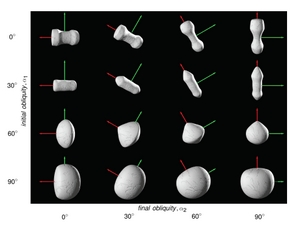- Details
- Published on 29 January 2019
Vol. 622
In section 1. Letters
Shape evolution of cometary nuclei via anisotropic mass loss
 Many comets present a bi-lobed or dummbell shape. This has been interpreted as various mechanisms including high-speed collisions, fission and reconfiguration, or slow merging of two proto-comets. The latter process in particular, has been invoked for comet 67P/Churyumov-Gerasimenko, where hundreds-of-meter thick strata are found on the two lobes but with different orientations. Vavilov et al. propose instead that bi-lobed cometary nuclei are a natural outcome of anisotropic mass loss due to sublimation. Even on an initially spherical comet, regions subject to enhanced insolation undergo preferential sublimation, producing a waist-like elongated shape. This reduces the moment of inertia around the comet's primary axis of rotation, making the comet prone to spin axis destabilization. Furthermore, in the "waist" region, the more pristine and volatile-richer interior is brought closer to the surface, ultimately creating non-convex neck-like shapes. Based on a simple mathematical description of these processes, the authors show that a large variety
of cometary shapes can be produced, matching spacecraft observations. In this scenario, the different orientations of the strata in the two lobes of 67P would be a consequence of the formation of the neck, followed by rotational fracturing and reconfiguration of the lobes.
Many comets present a bi-lobed or dummbell shape. This has been interpreted as various mechanisms including high-speed collisions, fission and reconfiguration, or slow merging of two proto-comets. The latter process in particular, has been invoked for comet 67P/Churyumov-Gerasimenko, where hundreds-of-meter thick strata are found on the two lobes but with different orientations. Vavilov et al. propose instead that bi-lobed cometary nuclei are a natural outcome of anisotropic mass loss due to sublimation. Even on an initially spherical comet, regions subject to enhanced insolation undergo preferential sublimation, producing a waist-like elongated shape. This reduces the moment of inertia around the comet's primary axis of rotation, making the comet prone to spin axis destabilization. Furthermore, in the "waist" region, the more pristine and volatile-richer interior is brought closer to the surface, ultimately creating non-convex neck-like shapes. Based on a simple mathematical description of these processes, the authors show that a large variety
of cometary shapes can be produced, matching spacecraft observations. In this scenario, the different orientations of the strata in the two lobes of 67P would be a consequence of the formation of the neck, followed by rotational fracturing and reconfiguration of the lobes.


